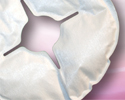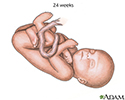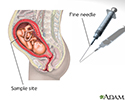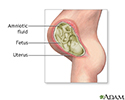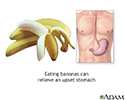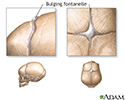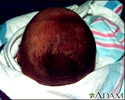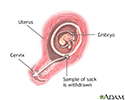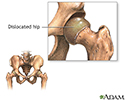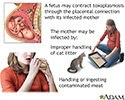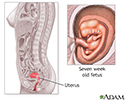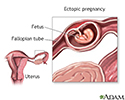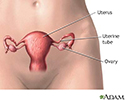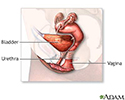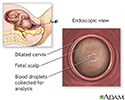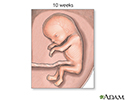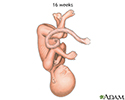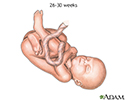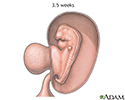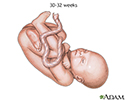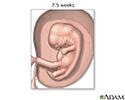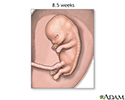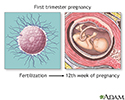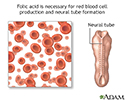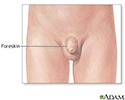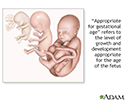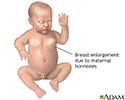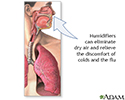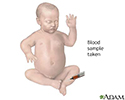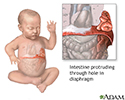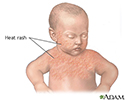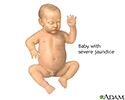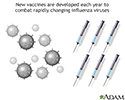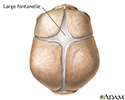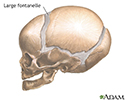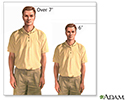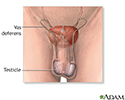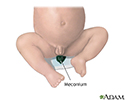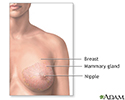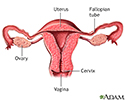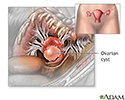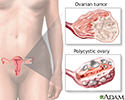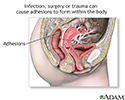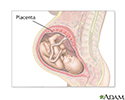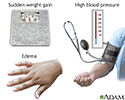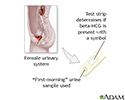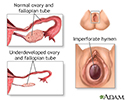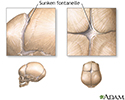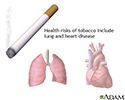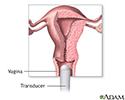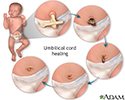Multimedia Gallery



Exchange transfusion - series
Exchange transfusion - series
Neonatal jaundice is a common problem among infants immediately after birth. It is the result of the inability of the neonatal liver to clear bilirubin, a breakdown product of blood cells, from the blood. Neonatal jaundice is usually a self-limiting, mild disorder. The most commonly used treatment is fluorescent light exposure, in which the infant is placed under a lamp for a few hours each day. The blue light breaks down bilirubin into a form the infant liver can process and eliminate.
Exchange transfusion - series
Exchange transfusion - series
Neonatal jaundice is a common problem among infants immediately after birth. It is the result of the inability of the neonatal liver to clear bilirub...
Exchange transfusion - series
Infant jaundice - Indication
Less frequently, when neonatal jaundice is more severe, and fluorescent light therapy is unable to break down all circulating bilirubin, exchange transfusion is often used. High levels of bilirubin in the blood can lead to brain damage and other serious problems. In these cases, exchange transfusion is a life-saving procedure designed to counteract the effects of serious jaundice, infection, or toxicity. The procedure involves the staged removal of the infant's blood and replacement with fresh donor blood or plasma.
Guidelines for an exchange transfusion include:
- Hemolytic disease of the newborn (Rh disease)
- Life-threatening infection
- Severe disturbances in body chemistry
- Toxic effects of drugs
- Polycythemia
Exchange transfusion - series
Infant jaundice - Indication
Less frequently, when neonatal jaundice is more severe, and fluorescent light therapy is unable to break down all circulating bilirubin, exchange tra...
Exchange transfusion - series
Exchange transfusion - Procedure
The infant is laid on his or her back, usually under a radiant warmer. The umbilical vein is catheterized with a fluid-filled catheter. The catheter is connected to an exchange transfusion set, incorporating lines to and from a waste container and a pack of donor blood. These are connected by means of a four-way stopcock, to which is also attached the syringe used to remove and replenish the infant's blood.
The exchange transfusion now goes ahead in cycles, each of a few minutes duration. Slowly the infant's blood is withdrawn, and the fresh, pre-warmed blood or plasma is injected. After the exchange transfusion, an umbilical catheter may be left in place in case the procedure needs to be repeated within a few hours.
Exchange transfusion - series
Exchange transfusion - Procedure
The infant is laid on his or her back, usually under a radiant warmer. The umbilical vein is catheterized with a fluid-filled catheter. The catheter ...
Review Date: 1/17/2025
Reviewed By: Charles I. Schwartz, MD, FAAP, Clinical Assistant Professor of Pediatrics, Perelman School of Medicine at the University of Pennsylvania, General Pediatrician at PennCare for Kids, Phoenixville, PA. Also reviewed by David C. Dugdale, MD, Medical Director, Brenda Conaway, Editorial Director, and the A.D.A.M. Editorial team.
Neonatal jaundice is a common problem among infants immediately after birth. It is the result of the inability of the neonatal liver to clear bilirubin, a breakdown product of blood cells, from the blood. Neonatal jaundice is usually a self-limiting, mild disorder. The most commonly used treatment is fluorescent light exposure, in which the infant is placed under a lamp for a few hours each day. The blue light breaks down bilirubin into a form the infant liver can process and eliminate.
Less frequently, when neonatal jaundice is more severe, and fluorescent light therapy is unable to break down all circulating bilirubin, exchange transfusion is often used. High levels of bilirubin in the blood can lead to brain damage and other serious problems. In these cases, exchange transfusion is a life-saving procedure designed to counteract the effects of serious jaundice, infection, or toxicity. The procedure involves the staged removal of the infant's blood and replacement with fresh donor blood or plasma.
Guidelines for an exchange transfusion include:
- Hemolytic disease of the newborn (Rh disease)
- Life-threatening infection
- Severe disturbances in body chemistry
- Toxic effects of drugs
- Polycythemia
The infant is laid on his or her back, usually under a radiant warmer. The umbilical vein is catheterized with a fluid-filled catheter. The catheter is connected to an exchange transfusion set, incorporating lines to and from a waste container and a pack of donor blood. These are connected by means of a four-way stopcock, to which is also attached the syringe used to remove and replenish the infant's blood.
The exchange transfusion now goes ahead in cycles, each of a few minutes duration. Slowly the infant's blood is withdrawn, and the fresh, pre-warmed blood or plasma is injected. After the exchange transfusion, an umbilical catheter may be left in place in case the procedure needs to be repeated within a few hours.



Animations
- Breast engorgement
- Cell division
- Cesarean section
- Conception - general
- Conception - pregnancy
- Conception of identical twins
- C-section
- Early labor
- Egg cell production
- Egg production
- Endometriosis
- Fetal ear development
- Formation of twins
- Human face formation
- Infant formulas
- Kids - How big is the baby?
- Kids - How does the baby co...
- Kids - Is it a girl or boy?
- Kids - Umbilical cord
- Kids - Where do babies come...
- Newborn jaundice
- NICU consultants and suppor...
- Ovulation
- Placenta delivery
- Placenta formation
- Preeclampsia
- Pregnancy
- Pregnancy care
- Sperm production
- Sperm release pathway
- Storing breast milk
- The role of amniotic fluid
- Twin-to-twin transfusion sy...
- Ultrasound
- Vaginal delivery
Illustrations
- 24-week fetus
- Abnormal discharge from the...
- Abnormal menstrual periods
- Absence of menstruation (am...
- Amniocentesis
- Amniocentesis
- Amniotic fluid
- Amniotic fluid
- Anatomy of a normal placenta
- Antibodies
- Baby burping position
- Bananas and nausea
- Blood cells
- Blood test
- Breast infection
- Breastfeeding
- Bulging fontanelles
- Candida - fluorescent stain
- Caput succedaneum
- Cesarean section
- Cesarean section
- Cesarean section
- Childbirth
- Chorionic villus sampling
- Congenital hip dislocation
- Congenital toxoplasmosis
- Crying - excessive (0 to 6 ...
- Delivery presentations
- Developmental milestones
- Early weeks of pregnancy
- Ectopic pregnancy
- Emergency Childbirth
- Emergency Childbirth
- Endocrine glands
- Endometriosis
- Endometritis
- Erythroblastosis fetalis - ...
- Female breast
- Female reproductive anatomy
- Female reproductive anatomy
- Female reproductive anatomy...
- Female urinary tract
- Fetal blood testing
- Fetal head molding
- Fetus at 10 weeks
- Fetus at 12 weeks
- Fetus at 16 weeks
- Fetus at 26 to 30 weeks
- Fetus at 3.5 weeks
- Fetus at 30 to 32 weeks
- Fetus at 7.5 weeks
- Fetus at 8.5 weeks
- First trimester of pregnancy
- Folic acid
- Folic acid benefits
- Folic acid source
- Follicle development
- Fontanelles
- Foreskin
- Gestational ages
- Gestational diabetes
- Gonadotropins
- Head circumference
- Heat rash
- Height/weight chart
- Hormonal effects in newborns
- Humidifiers and health
- Hysterectomy
- Infant blood sample
- Infant care following delivery
- Infant diaphragmatic hernia
- Infant heat rash
- Infant intestines
- Infant jaundice
- Infantile reflexes
- Influenza vaccines
- Intraductal papilloma
- Intrauterine transfusion
- Jaundiced infant
- Large fontanelles
- Large fontanelles (lateral view)
- Macrosomia
- Male reproductive anatomy
- Male reproductive anatomy
- Male urinary tract
- Mammary gland
- Meconium
- Morning sickness
- Moro reflex
- Newborn head molding
- Newborn test
- Normal female breast anatomy
- Normal uterine anatomy (cut...
- Ovarian cyst
- Ovarian hypofunction
- Overproductive ovaries
- Pelvic adhesions
- Pelvic laparoscopy
- Placenta
- Placenta
- Placenta
- Placenta previa
- Polyhydramnios
- Preeclampsia
- Pregnancy test
- Primary amenorrhea
- Primary infertility
- Secondary amenorrhea
- Secondary infection
- Side sectional view of fema...
- Single palmar crease
- Skull of a newborn
- Slit-lamp exam
- Sperm
- Stein-Leventhal syndrome
- Sunken fontanelles (superio...
- Tobacco health risks
- Transvaginal ultrasound
- Ultrasound in pregnancy
- Ultrasound, color - normal ...
- Ultrasound, normal fetus - ...
- Ultrasound, normal fetus - ...
- Ultrasound, normal fetus - ...
- Ultrasound, normal fetus - face
- Ultrasound, normal fetus - ...
- Ultrasound, normal fetus - foot
- Ultrasound, normal fetus - ...
- Ultrasound, normal fetus - ...
- Ultrasound, normal fetus - ...
- Ultrasound, normal fetus - ...
- Ultrasound, normal placenta...
- Ultrasound, normal relaxed ...
- Umbilical cord healing
- Uterus
- Vaginal bleeding during pre...
- Well baby visits
- Yeast infections

 Bookmark
Bookmark



























